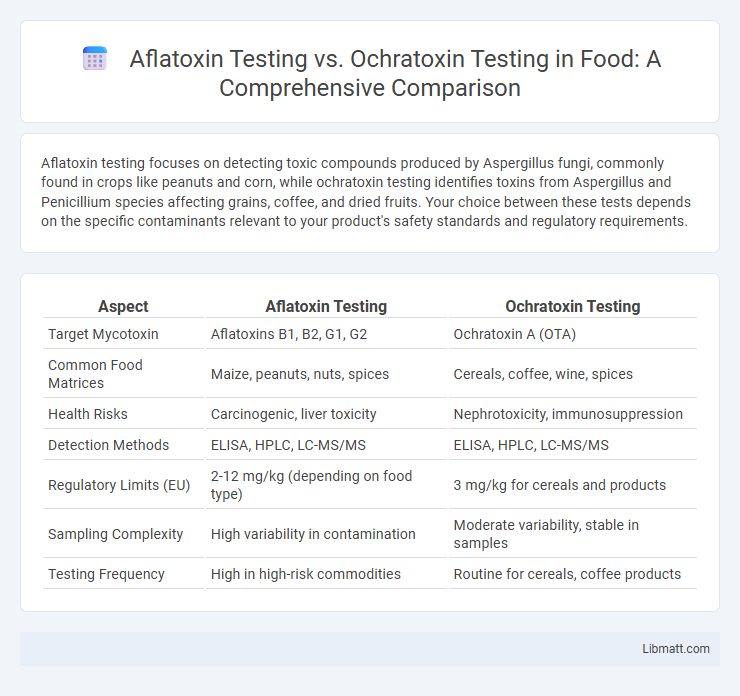Aflatoxin testing focuses on detecting toxic compounds produced by Aspergillus fungi, commonly found in crops like peanuts and corn, while ochratoxin testing identifies toxins from Aspergillus and Penicillium species affecting grains, coffee, and dried fruits. Your choice between these tests depends on the specific contaminants relevant to your product's safety standards and regulatory requirements.
Table of Comparison
| Aspect | Aflatoxin Testing | Ochratoxin Testing |
|---|---|---|
| Target Mycotoxin | Aflatoxins B1, B2, G1, G2 | Ochratoxin A (OTA) |
| Common Food Matrices | Maize, peanuts, nuts, spices | Cereals, coffee, wine, spices |
| Health Risks | Carcinogenic, liver toxicity | Nephrotoxicity, immunosuppression |
| Detection Methods | ELISA, HPLC, LC-MS/MS | ELISA, HPLC, LC-MS/MS |
| Regulatory Limits (EU) | 2-12 mg/kg (depending on food type) | 3 mg/kg for cereals and products |
| Sampling Complexity | High variability in contamination | Moderate variability, stable in samples |
| Testing Frequency | High in high-risk commodities | Routine for cereals, coffee products |
Introduction to Mycotoxins: Aflatoxin and Ochratoxin
Aflatoxin and ochratoxin are harmful mycotoxins produced by certain molds that contaminate food and agricultural products, posing significant health risks to humans and animals. Aflatoxin testing targets aflatoxins, known for their potent carcinogenic properties, commonly found in crops like peanuts and maize, while ochratoxin testing detects ochratoxins, which primarily affect kidney function and are often present in cereals, coffee, and dried fruits. Your awareness of these distinct toxins and their respective testing methods is essential for ensuring food safety and reducing exposure to these dangerous compounds.
Health Risks: Comparing Aflatoxin and Ochratoxin Contamination
Aflatoxin contamination primarily targets the liver, posing severe risks such as liver cancer and acute poisoning. Ochratoxin exposure mainly affects kidney function and may contribute to kidney disease and immunosuppression. Both mycotoxins present significant health hazards, but their toxicological impacts differ based on organ-specific toxicity and exposure levels.
Regulatory Standards for Aflatoxin and Ochratoxin Levels
Regulatory standards for aflatoxin and ochratoxin levels vary significantly to ensure food safety and compliance; aflatoxin limits are often stringent due to their high toxicity and carcinogenic potential, with maximum allowable levels typically ranging from 2 to 20 ppb depending on the country and the food product. Ochratoxin A is also regulated with strict limits, commonly set around 2 to 10 ppb for agricultural products, reflecting its nephrotoxic and carcinogenic risks. Understanding these regulatory thresholds is essential for Your testing protocols to effectively minimize contamination and meet international safety standards.
Sample Preparation Methods for Toxin Testing
Sample preparation methods for aflatoxin testing typically involve solvent extraction using mixtures like methanol-water or acetone-water to isolate toxins from grains or nuts, followed by filtration and sometimes immunoaffinity column cleanup to enhance detection accuracy. In contrast, ochratoxin testing often employs similar solvent extraction but may require pH adjustments and specific cleanup techniques such as solid-phase extraction to address ochratoxin's chemical properties and improve analytical sensitivity. Understanding these distinct preparation protocols ensures your sample's toxins are efficiently isolated, leading to reliable and precise contamination analysis.
Analytical Techniques in Aflatoxin Detection
Aflatoxin detection primarily relies on advanced analytical techniques such as high-performance liquid chromatography (HPLC) with fluorescence detection, enzyme-linked immunosorbent assay (ELISA), and liquid chromatography-tandem mass spectrometry (LC-MS/MS) for precise quantification and identification. These methods offer high sensitivity and specificity, enabling accurate screening of food and feed samples for aflatoxin contamination. In contrast, ochratoxin testing often utilizes HPLC coupled with fluorescence or mass spectrometric detection but differs in sample preparation and chromatographic conditions tailored to ochratoxin's chemical properties.
Analytical Techniques in Ochratoxin Detection
Ochratoxin detection primarily utilizes high-performance liquid chromatography (HPLC) combined with fluorescence detection or mass spectrometry for precise quantification. Immunoassays such as ELISA offer rapid screening but may require confirmation through chromatographic techniques to ensure accuracy. Your choice of analytical technique impacts sensitivity, specificity, and suitability for different sample matrices in ochratoxin testing.
Sensitivity and Accuracy: Aflatoxin vs Ochratoxin Testing
Aflatoxin testing demonstrates higher sensitivity, often detecting contaminants at parts-per-billion levels, while ochratoxin testing typically operates at slightly higher detection limits. Accuracy in aflatoxin assays benefits from extensively validated methods like HPLC and ELISA, providing reliable quantification in diverse matrices. Your choice between aflatoxin and ochratoxin testing should consider these differences to ensure precise risk assessment and compliance with regulatory standards.
Challenges in Mycotoxin Testing: Cross-Reactivity and Matrix Effects
Aflatoxin testing and ochratoxin testing both face significant challenges due to cross-reactivity, where antibodies or sensors may react with similar compounds, leading to false positives or inaccurate quantification. Matrix effects from complex food samples, such as grains or spices, interfere with the sensitivity and specificity of detection methods, requiring rigorous sample preparation and validation protocols. Understanding these hurdles is crucial for improving the accuracy of your mycotoxin testing to ensure food safety and regulatory compliance.
Technological Advances in Rapid Mycotoxin Screening
Technological advances in rapid mycotoxin screening have significantly improved the detection of aflatoxins and ochratoxins, utilizing methods such as immunoassays, biosensors, and liquid chromatography-mass spectrometry (LC-MS). Aflatoxin testing benefits from highly sensitive ELISA kits and portable fluorescence-based sensors, enabling quick field-level screening, while ochratoxin testing often employs advanced LC-MS techniques for precise quantification in complex food matrices. Your ability to rapidly identify these mycotoxins ensures better food safety management and compliance with regulatory standards.
Future Trends in Aflatoxin and Ochratoxin Testing
Future trends in aflatoxin and ochratoxin testing emphasize rapid, on-site detection technologies and advanced biosensors to improve food safety monitoring. You can expect increased integration of AI-driven data analytics for precise contamination assessment and real-time tracking in supply chains. Innovations focus on enhancing sensitivity, reducing costs, and expanding testing capabilities to address emerging mycotoxin risks globally.
Aflatoxin Testing vs Ochratoxin Testing Infographic

 libmatt.com
libmatt.com